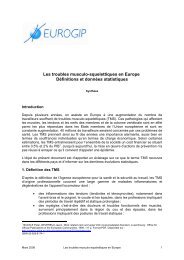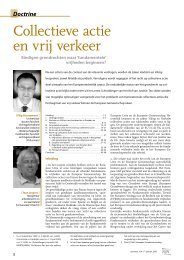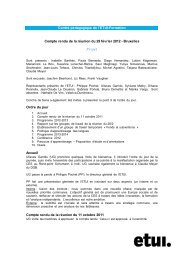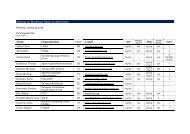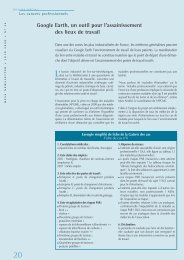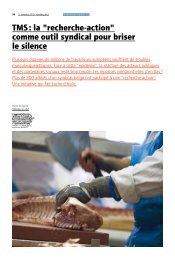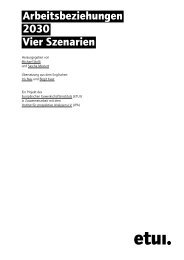Occupation and cancer - European Trade Union Institute (ETUI)
Occupation and cancer - European Trade Union Institute (ETUI)
Occupation and cancer - European Trade Union Institute (ETUI)
Create successful ePaper yourself
Turn your PDF publications into a flip-book with our unique Google optimized e-Paper software.
Acta Oncol Downloaded from informahealthcare.com by 212.35.100.66 on 04/06/11<br />
For personal use only.<br />
/ 100 000<br />
15<br />
10<br />
5<br />
Denmark<br />
Finl<strong>and</strong><br />
Icel<strong>and</strong><br />
Norway<br />
Sweden<br />
Men<br />
0<br />
1945 1960 1975 1990 2005<br />
lowest significant risks were found for women working<br />
as dentists (0.56, 0.33 0.90), technical workers<br />
<strong>and</strong> laboratory assistants (Table 51).<br />
The variation of the SIR was essentially larger<br />
when focused on only renal pelvis <strong>cancer</strong><br />
(http://astra.<strong>cancer</strong>.fi/NOCCA/Incidence/renal-pel<br />
vis), which constitutes about one-tenth of renal<br />
<strong>cancer</strong>s. High SIRs of <strong>cancer</strong> in men for renal pelvis<br />
<strong>cancer</strong> was observed among seamen (1.52, 1.26<br />
1.85), printers (1.39, 1.09 1.74), welders (1.39,<br />
1.05 1.80), public safety workers (1.34, 1.12 1.61)<br />
<strong>and</strong> textile workers (1.30, 1.04 1.61). Low-risk<br />
occupational groups included forestry workers<br />
(0.48, 0.36 0.62) <strong>and</strong> farmers (0.60, 0.55 0.66).<br />
Among women, a small increase in risk was found<br />
in clerical workers (1.19, 1.08 1.31) <strong>and</strong> shop<br />
workers (1.16, 1.04 1.31). Female religious etc.<br />
workers, on the contrary had the lowest significant<br />
risk (0.53, 0.29 0.89), followed by farmers (0.57,<br />
0.45 0.72) <strong>and</strong> gardeners (0.66, 0.50 0.86).<br />
Comment. Kidney <strong>cancer</strong> is associated with smoking<br />
<strong>and</strong> obesity [117]. Exposures <strong>and</strong> occupations<br />
previously reported to be associated with kidney<br />
<strong>cancer</strong> in a consistent way include trichloroethylene<br />
<strong>and</strong> coke production [118]. Workers in petroleumrelated<br />
<strong>and</strong> dry-cleaning industries, as well as workers<br />
exposed to gasoline, have previously been found<br />
to have an increased risk of renal <strong>cancer</strong> in Finl<strong>and</strong>.<br />
In the present study relatively little variation between<br />
occupations were seen, <strong>and</strong> no occupation presented<br />
a very high or very low SIR. In particular among<br />
women, there were no indications of any increased<br />
risk of kidney <strong>cancer</strong> associated with occupations.<br />
Work-related risks for <strong>cancer</strong> of the renal pelvis<br />
have been observed to resemble the occupational<br />
associations that are more clearly established for<br />
bladder <strong>cancer</strong> [117]. In the present study, all<br />
/ 100 000<br />
15<br />
10<br />
5<br />
<strong>Occupation</strong> <strong>and</strong> <strong>cancer</strong> in Nordic countries 723<br />
Denmark<br />
Finl<strong>and</strong><br />
Icel<strong>and</strong><br />
Norway<br />
Sweden<br />
Women<br />
0<br />
1945 1960 1975 1990 2005<br />
Figure 36. Age st<strong>and</strong>ardised (World) incidence rates for kidney <strong>cancer</strong> 1943 2005, by country <strong>and</strong> gender. Modified from NORDCAN<br />
[49].<br />
occupations with the highest SIR for <strong>cancer</strong> of the<br />
renal pelvis also had SIRs above 1.0 for bladder<br />
<strong>cancer</strong> (Tables 52 <strong>and</strong> 53), but the relative excess<br />
tended to be larger in renal cell <strong>cancer</strong>.<br />
Bladder <strong>cancer</strong><br />
The incidence of bladder <strong>cancer</strong> in the Nordic<br />
countries is several times higher in males than in<br />
females (Figure 37). There was an increasing<br />
incidence over time until the 1980s. The increase<br />
then levelled off in all countries, <strong>and</strong> even started to<br />
decline in Denmark <strong>and</strong> Finl<strong>and</strong>.<br />
Among men, the highest SIRs were observed<br />
in waiters (SIR 1.50, 95% CI 1.32 1.69), chimney<br />
sweeps, hairdressers, assistant nurses, seamen,<br />
cooks <strong>and</strong> stewards, plumbers <strong>and</strong> beverage workers<br />
(Table 52). The SIRs were lowest among farmers<br />
(0.68, 0.67 0.70), forestry workers <strong>and</strong> gardeners.<br />
The highest risks among women were found in<br />
tobacco workers (2.01, 1.49 2.65), printers, waiters,<br />
chemical process workers, sales agents <strong>and</strong> hairdressers<br />
(Table 53). Farmers (0.66, 0.62 0.72) <strong>and</strong><br />
gardeners had SIRs significantly below 1.0.<br />
Comment. Cigarette smoking is a well established<br />
cause of bladder <strong>cancer</strong> [121]. Several chemical<br />
exposures have been associated with the development<br />
of bladder <strong>cancer</strong>. They include 4-aminobiphenyl,<br />
benzidine, coal tars <strong>and</strong> pitches, mineral<br />
oils, untreated <strong>and</strong> mildly treated 2-naphthylaminec,<br />
benz[a]anthracene, benz[a]pyrene, benzidinebased<br />
dyes, 4-chloro-ortho-toluidine, dibenz[a, h]<br />
anthracene, diesel engine exhaust, 4,4 -methylenebis(2-chloroaniline)<br />
(MOCA) <strong>and</strong> polychlorinated<br />
biphenyls [95]. Some industrial processes <strong>and</strong><br />
occupations have also been identified as being<br />
associated with the development of bladder can-




